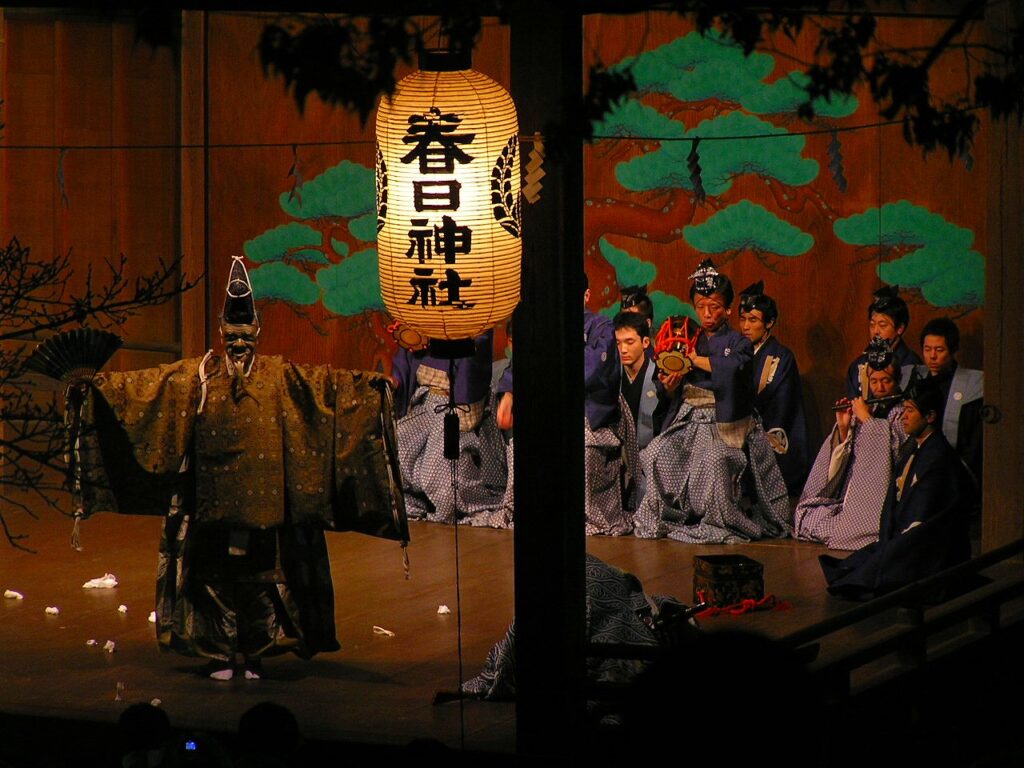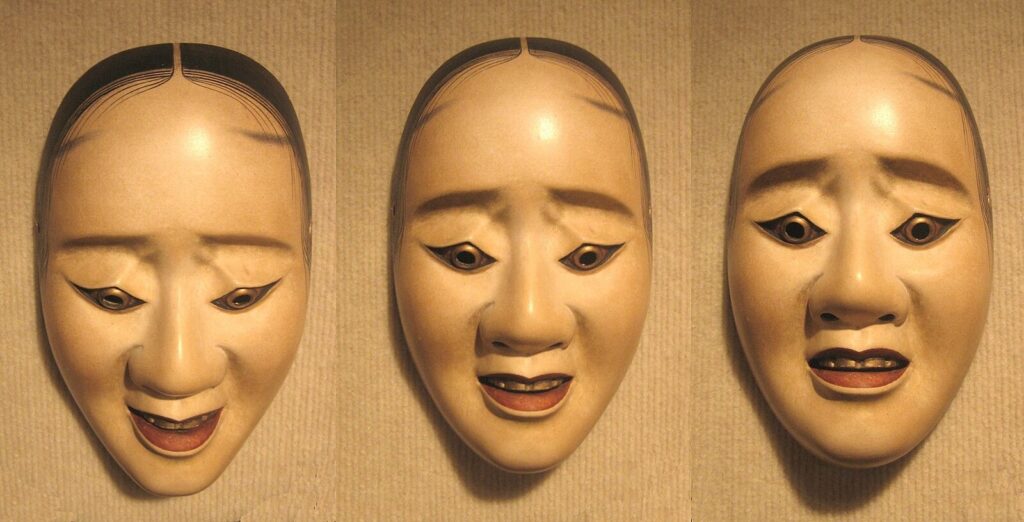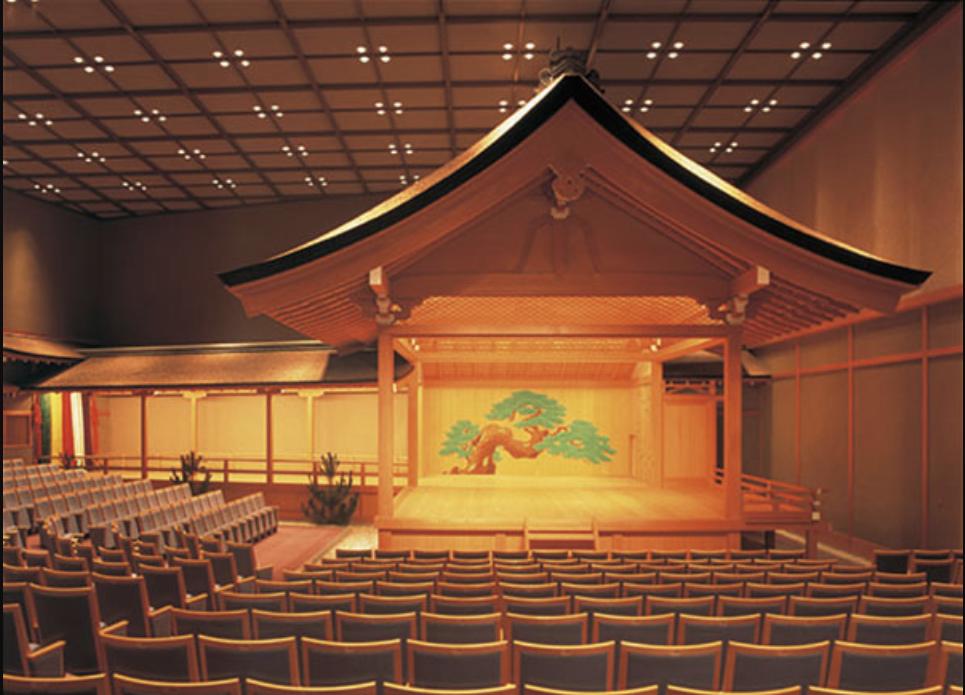
“The artistic expressions of any ethnic culture are known to have an intimate connection with its religiosity when their origins are traced back, and in Japan a tradition was established to understand the essence of the arts based on the Buddhist self-cultivation theory” (Yuasa Yasuo).
The theory of Buddhist self-cultivation “was incorporated into the arts toward the end of the Heian period (714-1185), and during the Kamakura and the Muromachi periods (1185-1573), it shaped theories of artistry in such areas as waka poetry, No or Nogaku theater, and Sado (the way of tea).”
The aesthetic experience has been sought in analogy with the experience of satori
Yuasa writes: “Generally speaking, the goal of self-cultivation is to pursue ‘satori’, and the goal of the arts is to pursue ‘beauty’. Accordingly, the ultimate, ideal condition of aesthetic experience has been sought in analogy or comparison with the experience of satori. The term ‘yugen’ (profound, suggestive mystery) is a case in point. Fujiwara Shunzei (1114-1204), a poet toward the end of the Heian period, was the first to use this term, which was suggested by the Tendai text Makashikan … Fujiwara Shunzei reasoned that a poet can achieve the ideal aesthetic state of beauty, or yugen, just as a monk achieves satori through self-cultivation.”
In fact, “the artistic expressions of any ethnic culture are known to have an intimate connection with its religiosity when their origins are traced back, and in Japan a tradition was established to understand the essence of the arts based on the Buddhist self-cultivation theory.”
Waka Poetry
The Kokin Wakashu, comprising more than a thousand poems, was compiled in the 10th century, at the end of the Heian period which Yuasa identifies as the formative period of Japanese culture.
Although not as well known as haiku, waka poetry has an important place in classic Japanese literature. The Kokin Wakashu, comprising more than a thousand waka poems, was compiled in the 10th century, at the end of the Heian period which Yuasa identifies as the formative period of the Japanese culture. Formally, a waka poem has five lines and a syllable count of 5-7-5-7-7, similar to the haiku but with two additional lines. It has traditionally been used to grasp sights, sounds, feelings and smells, just as the haiku does, but it can also express strong emotions felt by a poet, or a scholar, at a moment of turmoil. In 1934, at a time when the nationalist wave was threatening to engulf Japanese politics, Nishida wrote the famous waka that is now inscribed on a monument near the Philosopher’s Path in Kyoto:
“People are people;
I am I;
Unperturbed;
I take the path;
I take.”
Earlier, as he had gone through a particularly painful period of his life, with several of his children having died and his wife struck with paralysis, Nishida had written the following waka in his diary:
“Am I to live
in this miserable way
in this world
not a day of peace
in the last five years.”
In Zen and Philosophy, an intellectual biography of Nishida, Michiko Yusa, writes: “At the same time strong life energy was springing inside him, repelling these negative thoughts. This feeling of affirmation is found in another waka.”
“Just like the brilliant sunset
over Mount Atago
may the rest of my life
be totally expended
like a fire aflame.”
Yuasa defines waka poetry in terms of yugen – profound, suggestive mystery – which, as we saw, Fujiwara Shunzei defines as the aesthetic equivalent of satori in a spiritual practice. Yuasa writes: “In the Kamakura period (1185-1333), however, waka poetry was widely theorized in analogy with dharani in a theory called waka-dharani. Dharani refers to sacred spells used in Buddhism, and in this case, means a sacred word symbolically expressing the world of Buddha. According to this theory, an excellent waka poem expresses the state of yugen in words, just as dharani expresses the state of satori which ordinary people cannot easily achieve. In this case, a poet pursues beauty, expressed by the word yugen, through the practice [keiko] of poetic composition, that is, through training the mind in attempting to compose better poems, just as the monk attempts to achieve satori through self-cultivation. Accordingly, the theory was formulated such that a poet can reach beauty by training and polishing his or her mind. This is the theory of “kado,” the way of waka poetry composition, which regards the method of poetic composition as a kind of culturing and nurturing of the personality.”
Noh Theater
A similar expression of the state of yugen is sought in the Noh theater, which was systematised in the 14th century, during the Muromachi period (1336-1573) by Zeami Motokiyo, who reinterpreted various traditional performing arts, giving Noh the form it has kept to the present. The translator of Yuasa’s book has retained the Japanese word “No,” but the term now used in the West seems to be spelled “Noh.” “No” derived from a Sino-Japanese word meaning “skill” or “talent.” It is a dance-based performance, where emotions are primarily conveyed by stylized conventional gestures while the iconic masks represent the roles such as ghosts, women, deities, and demons.

The Encyclopedia Britannica describes it as follows: “Rather than being actors or ‘representers’ in the Western sense, Noh performers are simply storytellers who use their visual appearances and their movements to suggest the essence of their tale rather than to enact it. Little ‘happens’ in a Noh drama, and the total effect is less that of a present action than of a simile or metaphor made visual. The educated spectators know the story’s plot very well, so that what they appreciate are the symbols and subtle allusions to Japanese cultural history contained in the words and movements.”
Yuasa writes: “Zeami (1363-1443), a great systematizer and formulator of the No theatre, symbolically expresses beauty in No theatre by the word “flower”[hana]. The term “flower” corresponds to “yugen” in the way of waka poetry composition. In other words, No is an art which attempts to express the “flower” through the use of the body. Fundamental to this theatrical art are its performing techniques, which Zeami calls “waza,” and its training “keiko” (practice). In other words, just as a monk endeavors to achieve satori through self-cultivation, so a No performer endeavors to make the “flower” blossom on stage by repeated practice of performing techniques change the mind-body relationship. How, then, does the practice of performing techniques change the body-mind relationship?
Yuasa notes that for a toddler walking is difficult, yet for most of us it is something we can do without thinking about it. Through repetition, we have “embodied” the art of walking. The same thing applies to the training of a professional performer of the Noh theater. A close look at the process of training throws light on the gap between living dualistically and body-mind oneness. In Yuasa’s words: “At the beginner’s stage, whether in a theatrical performance, dance, or sport, the student tries to move his or her body first by thinking, as it were, through the head. In other words, the student intellectually understands and calculates the teacher’s instruction, according to which he or she then tries to control the body. Nevertheless, the body does not move as one’s mind wishes. Here, mind and body are lived dualistically. The mind qua thinking consciousness and the body, which is moved following the command of the mind, are understood separately.However, if one continues to train oneself repeatedly, the body gradually comes to move in accordance with the mind’s wishes … This is because the “body” has learned. When this process is repeatedly and diligently practiced, the student comes to move his or her body freely and unconsciously. The ideal state can be referred to as “body-mind oneness.” There is no gap between the movement of the mind and that of the body in the performance of a master, for the master’s mind and body are one.”
Yuasa accepts that his process of training is the same in Western theatrical performance and sports. But he argues that “since the tradition of a mind-body dualistic pattern of thinking is strong in the West … there is a strong tendency to train the body through conscious calculation. That is, the assumption is that training proceeds from mind to body, or from mind to form. Contrary to this order, the tradition of Eastern self-cultivation places importance on entering the mind from the body or form. That is, it attempts to train the mind by training the body. Consequently, the mind is not simply consciousness nor is it constant and unchangeable, but rather it is that which is transformed through training the body.”
Another fundamental difference Yuasa points out with regard to theatrical performance in the East as compared to the West, is that “traditional theories of art in the West have understood beauty by emphasizing the standpoint of the observer. For example, according to Aristotle’s theory of art, which is the classic theory of theater, the essence of tragedy is catharsis of the soul.” In contrast, although theater in the East cannot disregard the audience’s standpoint, “a characteristic of Japanese artistry is that its fundamental emphasis is placed more on the standpoint of the performer than on that of the audience.”This was already the case in waka poetry. “The theory of waka composition maintains that a poet achieves the state of yugen through training in waka poetry, and Zeami’s story of No theater teaches the embodiment of ‘flower’ by a performer … The artist requires the catharsis and enhancement of his or her mind in pursuit of beauty, just as does the cultivator in pursuit of satori.” The performing techniques (waza) function as seeds that allow the “flower” (which Yuasa equates with yugen) to blossom. Yuasa tells us that “Zeami contends that the flower which blossoms through bodily training is the No mind, the mind of No performance. In Zeami’s understanding, the mind-body relationship is taken in an order proceeding from performing techniques [waza] qua the seeds to the ‘flower’, that is, from the body or the form to the mind. Therefore, the mind is understood as that which is transformed and reborn constantly through the form, as the flower grows and blossoms …. Zeami calls the ideal state of ‘flower’, ‘no-mind,’ (mushin) or ‘emptiness’ (ku). It is freedom in dancing without consciousness of its performance. In other words, it is a state of ‘body-mind oneness’ where the movement of mind and body become indistinguishable. It is a state of self-forgetfulness, in which consciousness of oneself as the subject of bodily movement disappears and becomes the movement itself that is dancing.”
In the state of everyday ordinary consciousness, the mind is the subject that dominates and moves the body that is an object. “This,” Yuasa says, “is conscious bodily movement. In the state of body-mind oneness, the mind moves while unconsciously becoming one with the body. That is, there is no longer a felt distinction between the mind qua subject and the body qua object; the subject is simultaneously the object, and the object is simultaneously the subject.”
Yuasa adds: “The philosopher Nishida Kitaro (1870-1945) refers to this state as ‘pure experience’ [junsui keiken] or ‘acting intuition’ (koiteki chokkan). Nishida maintains that ‘acting’ is at the same time intuiting emptiness (absolute nothing [zettaimu]).He characterizes it as ‘becoming a thing, and penetrating into things’. The mind becomes entirely a ‘thing’, that is the body, demonstrating to the fullest the capacities and possibilities endowed in the body (a thing), and it moves penetrating things around it. The center of this bodily movement is a ‘stillness’ in the midst of dynamism, just as the center pin of a top spinning at full speed remains stationary.”
In the West as well, artists and athletes talk of “being in the zone“ or “in the flow,” and this state of oneness has been compared with no-mind” (mushin).
Sources:
Yuasa Yasuo – The Body, Self-Cultivation, and Ki-Energy
Michiko Yusa – Zen & Philosophy – An Intellectual Biography of Nishida Kitaro

